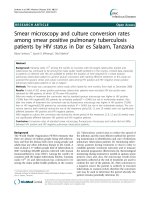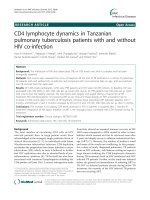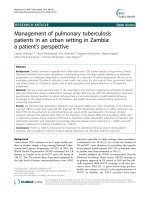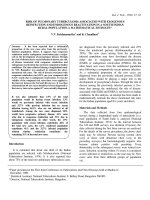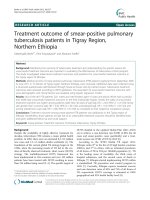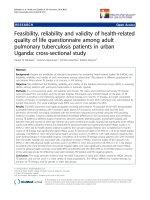CD4 lymphocyte dynamics in Tanzanian pulmonary tuberculosis patients with and without HIV co-infection ppt
Bạn đang xem bản rút gọn của tài liệu. Xem và tải ngay bản đầy đủ của tài liệu tại đây (256.93 KB, 7 trang )
RESEARCH ARTICLE Open Access
CD4 lymphocyte dynamics in Tanzanian
pulmonary tuberculosis patients with and without
HIV co-infection
Aase B Andersen
1*
, Nyagosya S Range
2
, John Changalucha
3
, George PrayGod
3
, Jeremiah Kidola
3
,
Daniel Faurholt-Jepsen
4
, Henrik Krarup
5
, Harleen MS Grewal
6
and Henrik Friis
4
Abstract
Background: The interaction of HIV and tuberculosis (TB) on CD4 levels over time is complex and has been
divergently reported.
Methods: CD4 counts were assessed from time of diagnosis till the end of TB treatment in a cohort of pulmonary
TB patients with and without HIV co-infection and compared with cross-sectional data on age- and sex-matched
non-TB controls from the same area.
Results: Of 1,605 study participants, 1,250 were PTB patients and 355 were non-TB controls. At baseline, HIV was
associated with 246 (95% CI: 203; 279) cells per μL lower CD4 counts. All PTB patients had 100 cells per μL lower
CD4 counts than the healthy controls. The CD4 levels were largely unchanged during a five-month of TB
treatment. HIV infected patients not receiving ART at any time and those already on ART at baseline had no
increase in CD4 counts after 5 months of TB treatment, whereas those prescribed ART between baseline and 2
months, and between 2 and 5 months increased by 69 (22;117) and 110 (52; 168) CD4 cells per μL after 5 months.
Conclusions: The increase in circulating CD4 levels observed in PTB in patients is acquired after 2 months of
treatment irrespective of HIV status. Initiation of ART is the strongest factor correlated with CD4 increase during TB
treatment.
Trial registration number: Clinical trials.gov: NCT00311298
Keywords: Pulmonary tuberculosis, HIV, CD4 cells, TB treatment
Background
The total number of circulating CD4 cells in HIV
infected patients have in large patient series been
acknowledged as the strongest, single predictive factor of
clinical deterioration [1-3]. In individuals with latent
Mycobacterium tuberculosis infection, CD4 depletion
accelerates the progression from latent infection to active
tuberculosis (TB), which, in turn, is believed to further
fuel HIV replication rates due to elevated levels of pro-
inflammatory cytokines [4]. TB b y itself has also been
associated w ith transitory lymphopenia including the
CD4 positive cell lines [5,6]. A recent, retrospective study
from Italy showed an impaired immune recovery in TB/
AIDS cases compared to AIDS caused by other co mor-
bidities which seemed no t the be retrieved eve n after
3 years and despite access to efficient antiretroviral ther-
apy (ART) [7]. However, the number of studies is small
and some of the results are conflicting. In this prospec-
tive cohort of newly diagnosed pulmonary TB patients
from an HIV e ndemic, sub-Saharan setting we report a
large dataset studying the CD4 lymphocyte dynamics
during TB treatment; both in HIV uninfected and HIV
infected TB patients. Further, as this study was initiated
before the general recommendation of initiating ART in
TB-HIV co-infected patients already during active TB
treatment, the ma jority of the HIV infected TB patients
were not receiving ART.
* Correspondence: rk.dk
1
Department of Infectious Diseases, Odense University Hospital, University of
Southern Denmark, Sdr. Boulevard 29, DK 5000 Odense C, Denmark
Full list of author information is available at the end of the article
Andersen et al. BMC Infectious Diseases 2012, 12:66
/>© 2012 Andersen et al; licensee BioMed Central Ltd. This is an Open Access article distributed under the terms of the Creative
Commons Attribution License ( which permits unrest ricted use, distribution, and
reproduction in any medium, provided the original work is prope rly cited.
Methods
Study design
The study was conducted from April 2006 to March 2009
in Mwanza, Tanzania. Pulmonary TB (PTB) patients
were enrolled at four TB clinics in Mwanza city as part of
a clinical trial on nutrition in PTB patients (clinical trial
registration number NCT0031129 8 accessible at http://
clinicaltrials.gov/ct2/show/NCT00311298, after giving
informed consent [8,9]. The primary outcome of the
study was weight gain at 2 and 5 month of in tervention
with energy and micronutrient enriched biscuits admini-
strated through the initial 2 months of the TB treatment.
A secondary outcome measure was to study the CD4
levels at 2 and 5 months. Pregnancy, age under 15 years,
or terminal illness led to exclusion. The diagnosis of TB
followed the World Health Organization (WHO) guide-
lines [10]. All TB susp ects were asked to bring three spu-
tum samples for smear microscopy after Ziehl-Nielsen
stain, a fourth sample was obtained for culture on Loe-
wenstein-Jensen substrate and the patients were asked to
have a chest X-ray as appropriate [10,11]. Patients were
classified as PTB+ if Mycobacterium tuberculosis could
be cultured from the sample. In case of a negative culture
or contamination, the diagnosis relied on positive micro-
scopy of two samples or one microscopy positive sample
and a chest X-ray suggestive of TB. A patient was consid-
ered PTB-smear -negative (PTB-) if all samples were cul-
ture and microscopy negative, but the TB diagnosis
retained because chest X-ray was suggestive of T B, and
there was no clinical response to a course of broad-spec-
trum antibiotics. After diagnosis, all pat ients were pre-
scribed a standardized TB treatment for 6-8 months
based on existing national gu idelines [10,11]. The man-
agement of HIV infection was based on national guide-
lines at the tim e of the study [12]. P atients were
supposed to start antiretroviral therapy (ART) if they had
CD4 count of < 200 cells per μL, those with WHO stage
4 illness and/or CD4 count of 200-350 cells per μLwere
supposed to start ART after completion of 2 months of
TB treatment. Patients who developed TB after starting
ART continued ART throughout TB treatment.
Recruitment of non-TB controls
The city of Mwanza is divided into wards, streets and
communal cells. Each cell holds 10-20 households, and is
headed by a so-called “ten cell-leader”. Each of the PTB+
patients enrolled was asked to provide his/her residential
address and the name of his/her ten-cell leader. The
study team requested the ten-cell leader to provide a
complete list of individuals in his/her jurisdiction meet-
ing the age- a nd-sex recruitment criteria. Of these, one
was randomly selected using a lottery method and invited
to participate in the study as a non-TB control if he/she
met the following criteria: no history o f previous active
TB or TB treatment, no evidence of current active TB
(absence of cough, intermittent fevers, and excessive
night sweating in the past 2 weeks and absence of unex-
plained weight loss in the past month), same sex as index
case, aged 1 5 years or above and age differen ce from
indexcasewasnotmorethanfiveyears,hadlivedinthe
same street as index case for at least 3 months, not preg-
nant, and consenting to participate in the study. Persons
who were terminally ill were not invited.
Data collection
Data on demogr aphy, smoking, and alcohol intake were
collected using questionnaires while data on ART were
retrieved from antiretroviral-use databases in ART
clinics. Between 8 and 12 a.m., blood was collected for
HIV testing and for CD4 cell quantifying. HIV status
was determined using “Capillus HIV-1/HIV-2” (Trinity
Biotech Plc., Wicklow, Ireland) and “ Det erm ine HIV-1/
HIV-2” (Inverness Medical Innovations, Inc., Delaware,
USA) tests in parallel. HIV infection was diagnosed i f
both tests gave a positive result and an HIV negative
diagnosis was made if both tests gave a n egative result.
Indeterminate results were resolved using ELISA
“Organon Uniform II” (Organon Teknia Ltd, Boxtel, the
Netherlands). CD4 counts were determined as cells per
μlusinga“ Partec Cyflow Counter” (Partec GmbH,
Münster, FRG) using the reagents suggested by the
manufacturer: “Partec CD4 easy count kit 05-8401”.
Statistical methods
Data were double entered in EpiData (EpiData Associa-
tion, Denmark) and anal ysed using Stata/IC version 11.2
(StataCorp, TX, USA). Normal probability plots were used
to assess normality of continuous variables. Differences in
categorical and continuous variables between groups were
tested using chi-square test and t test or oneway analyses
of varience, respectively. If the oneway analyses of variance
was significant, then Scheffe multiple-comparison post
hoc tests for differences between groups was done. Linear
regression wasused to adjust for potential confounders
and to test for interac tions. P-values < 0.05 were consid-
ered significant.
Ethical considerations
Ethical permission was obtained from the National
Medical Research Coordinating Co mmittee of the
National Institute of Medical Research in Tanzania and
approval from the Danish National Committee on Bio-
medical Research Ethics. Written and oral information
was presented to all eligible participants before written
consent was obtained. Written consent was obtained
from parents/legal guardians of any participants under
Andersen et al. BMC Infectious Diseases 2012, 12:66
/>Page 2 of 7
18 years of age. Patients were offered pre- and post-test
HIV counseling and referred to nearby antiretroviral
clinics for management if they tested positive.
Results
A total of 3,397 patients were eligible for the study, but
201 were below 15 years of age, 484 had extra-pulmonary
TB,49werepregnant,113considered terminally ill and
1,239 were non-residents of the area. 61 patients were eli-
gible but refused consent leaving 1,250 PTB patients to
be included in the study. A total of 355 healthy controls
were recruited from the neighborhood area and included
as non-TB controls. Background characteristics are
shown in Table 1. There were no differences in mean age
between PTB+ patients and non-TB controls (0.8 years,
95% CI: -0.7; 2.3), since controls were selected among
neighbors with same sex and similar age to PTB+ index
cases. However, the mean age was 2.5 (95% CI: 1.04;
4.03) years higher in all PT B patients compared to non-
TB controls. This was due to a 5.0 (95% CI: 3.5; 6.5)
years higher mean age in PTB- compared to PTB+
patients. The prevalence of HIV infection was 50.6%
(633) among the 1,250 PTB patients, and 9.9% (35)
among the 355 non-TB controls (p < 0.001).
CD4 levels before TB treatment
Data on CD4 counts were available on 1,604 (99.9%) of
the 1,605 participants. The mean CD4 count was 416
(95% CI: 399; 433) cells per μ L in PTB patients and 631
(95% CI: 595; 667) cells per μL in non-TB controls
(Table 2). Thus, th e CD4 count was 215 (95% CI: 178;
253) cells per μL lower among PTB patients compared to
controls, partly due to confounding by H IV. Among HIV
uninfected participants, the mean CD4 c ount was 105
(95% CI: 59; 151) cells per μL lower in PTB patients, and
in HIV infected participants it was 128 (95% CI: 57; 198)
cells per μL lower (Table 2). Accordingly, in linear
regression analyses, there was no interaction between
PTB and HIV status with respect to CD4 counts (interac-
tion, p = 0.68).
The independent effects of PTB and HIV status were
estimated in the multivariate model, while adjust ing for
age and sex (Table 3). Age was adjusted for using
dummy variables with below 25 years as reference cate-
gory. Ages between 25 and 35, 35-45 and 45 years and
above were associated with 114, 106 and 71 cell per μL
lower CD4 count compared to the age below 25 years.
Sex was not a predictor of CD4 count (95% CI: -45; 15).
As seen, both PTB+ and PTB- status was associated with
around 100 cells per μL lower CD4 counts, while HIV
infection was associated with around 250 cells per μ L
lower CD4 count. The intercept of 736 (95% CI: 695;
778) reflects the mean CD4 count among individu als fall-
ing into all the reference categories; i.e. female non-TB
controls without HIV infection and age below 25 years.
CD4 levels during TB treatment
Of the 1,250 PTB patients, 1,119 (89.6%) had their CD4
cells determined again after 2 months and 1,020 (81.6%)
after 5 months of treatment. The changes in CD4 count
during TB treatment seemed to depend on PTB and HIV
status (Figure 1). As seen in Table 4, among HIV unin-
fected PTB- patients the changes in CD4 count were -39
(95% CI: -106; 28) after two and -60 (95% CI: -143; 22)
cells per μL after 5 months of treatment. In contrast, HIV
infected PTB+ patients had a significant increase after 2
months (78 cells per μL, 95% CI: 39; 117), which disap-
peared after 5 months (14 cells per μL, 95% CI: -28; 55).
Table 1 Background characteristics of 1,250 pulmonary tuberculosis (TB) patients and 355 neighborhood controls
1
Pulmonary TB patients (n = 1250) Controls (n = 355) P
Age (y) 36.5 (35.7; 37.2) 33.9 (32.7; 35.2) < 0.001
Female sex, % (n) 40.8 (510) 45.4 (161) 0.13
Ethnicity, % (n)
Wasukuma 45.6 (570) 46.3 (164) 0.82
Marital status, % (n)
Single 24.8 (308) 25.2 (89) < 0.001
Married/cohabiting 53.1 (658) 68.8 (243)
Separated/divorced/widowed 22.1 (274) 6.0 (21)
Occupation, % (n)
Farmer/fisherman 39.1 (488) 32.2 (114) 0.06
Business/employed 36.1 (450) 40.4 (143)
Other 24.8 (309) 27.4 (97)
HIV infection, % (n) 50.6 (633) 9.9 (35) < 0.001
1
Pulmonary TB status was based on culture, except where culture data were not available. For each of 355 consecutive sputum positive TB patients an age- and
sex-matched neighborhood control was selected. Data or mean (95% confidence interval) or % (n).
Andersen et al. BMC Infectious Diseases 2012, 12:66
/>Page 3 of 7
At 2 months, the change in CD4 count in HIV uninfected
was 118 (95% CI: 37; 199) cells per μLhigherinPTB+
compared to PTB- patients (p = 0.004). Among HIV
infected PTB pati ents, the changes in CD4 coun t were
similar to that of HIV uninfected PTB+ patients, i.e. signif-
icant, but transient increments in CD4 counts (Table 4).
However, in HIV patients ART status and the timing of
initiation of ART were major determinants of the change
in CD4 count during TB treatment.
According to questionnaire data as well as data from the
ART clinic registers, 80 (12.6%) of the 633 PTB patients
with HIV co-infection were on ART at the time they
started TB treatment. The remaining 553 (87.4%) were all
referred to ART clinics. Two and five months after start of
TB treatment 167 (26.4%) and 222 (35.1% ), respectively,
were on ART. However, not all came for their two and
five-month follow-up visits. Of the 546 (86.3%) HIV
infected who came for their 2 months follow-up visit and
had their CD4 count determined, 144 (26.4%) were on
ART. Similarly, among 500 (79.0%) HIV infected exam-
ined at 5 months, 183 (36.6%) were on ART.
The chang es in CD4 count d uring TB treatment
among the 633 HIV co-infected PTB patients are shown
in Table 5 by the four categories defined by ART status
and timing of ART initiation. The four categories are: 1)
not on ART at any time during the study, 2) on ART at
baseline, 3) put on ART between the baseline and the 2
month examination and 4) on ART between the 2 and 5
months examination. As seen, the CD4 counts differed
significantly between these four categories at baseline
and after 2 months, but not after 5 months. At baseline,
those who were not put on ART (prior to the 5 months
follow-up examination) had the highest mean CD4
count. Of the remaining three categories, the CD4
count w as highest in those already on ART, and lowest
in those put on ART between the baseline and 2
months examination.
The changes in CD4 count up to 2 months did not differ
between the four groups (Table 5). In contrast, the
changes from baseline to 5 months were different between
thegroups.Infact,onlythose prescribed ART between
baseline and 2 months (69 cells per μL; 95% CI: 22; 117)
and between 2 and 5 months ( 110 cells per μL, 95% CI:
52; 168) had sustained increments in CD4 counts.
Discussion and Conclusions
This study shows that the decrease in circulating CD4
lymphocytes induced by TB has occurred before the diag-
nosis is made. The pattern was the same for both TB
patients with and without HIV co-infection. HIV unin-
fected PTB patien ts had signific antly lower CD4 levels
than healthy controls at baseline and did not reach the
same levels of circulating CD4 cells even after 5 months of
TB treatment. This could either be explained by continued
sequestering of cells to the lungs or due to apoptosis and
persistent regulatory stimuli even at this late stage towards
Table 2 CD4 counts among 1,250 pulmonary tuberculosis (TB) patients and 355 neighborhood controls
1
TB patients
(n = 1250)
Controls
(n = 355)
Difference (controls - TB) P
CD4 counts (cells per μL) 416 (399; 433) 631 (595; 667) 215 (178; 253) < 0.001
In HIV uninfected 550 (523; 577) 655 (617; 693) 105 (59; 151) < 0.001
In HIV infected 285 (269; 301) 413 (330; 495) 128 (57; 198) < 0.001
1
Pulmonary TB status was based on culture, except where culture data were not available, in which case microscopy results were used. From each of 355
consecutive sputum positive TB patients an age and sex-matched neighborhood control were selected.
Table 3 Predictors of CD4 count (cells per μL) among 1,250 pulmonary tuberculosis (TB) patients starting TB
treatment and 355 controls with regression coefficients B, 95% confidence interval (95% CI) and p-values
1
Univariate Multivariate
2
B (95% CI) P B (95% CI) P
Pulmonary TB status
Controls (n = 355) - -
PTB negative (n = 427) -247 (-292; -203) < 0.001 -103 (-147; -58) < 0.001
PTB positive (n = 822) -199 (-238; -160) < 0.001 -109 (-146; -71) < 0.001
HIV status
Uninfected (n = 937) - -
Infected (n = 667) -294 (-323; -265) < 0.001 -246 (-279; -215) < 0.001
1
Pulmonary TB status was based on culture, except if culture data were missing in which case microscopy results were used. From each of 355 consecutive PTB
positive TB patients, an age- and sex-matched neighborhood control was selected, and used as reference category.
2
Adjusted for sex and age. Age was included as dummy variable with below 25 years as reference category. N = 1604, R
2
= 0.23, intercept 736 (95% CI: 695;
778).
Andersen et al. BMC Infectious Diseases 2012, 12:66
/>Page 4 of 7
the end of treatment [13-15]. The HIV infected TB
patients who were already on ART at time of TB diagnosis
likewise did not increase their pool of circulating CD4
cells during the 5 months observation and treatment per-
iod. However, the HIV patients either put on ART within
the first 2 months or from the second to the fifth month,
experienced an increase in CD4 lymphocytes of 69 (95%
CI: 22; 117) and 110 (95% CI: 52; 168). A weakness of our
study is the lack of data regarding symptoms of Immune
Reconstitution Inflamm atory Syndrome (IRIS), which
might have explained some of the CD4 fluctuations. The
incidences of IRIS have been variably reported but higher
in patients receiving early ART and in patients with low
CD4 counts [16,17].
The data were analysed separately for PTB+ and PTB-
patients because the PTB- patients probably represent a
rather inhomogeneous group. These patients may range
from HIV uninfected individuals with early clinical mani-
festations of pulmonary TB to severely immune s up-
pressed HIV infected p atients who are excreting too few
bacteria to be detected in ordinary sputum samples. There
was no access to enhanced diagnostic procedures like
induced sputum mane uvers or bronchoscopy in this set-
ting. A subgroup of the patients may not even have TB
but have pulmonary symptoms for other reasons even
though the criteria for initiating TB treatment in smear
negative patients according to WHO guidelines were fol-
lowed. It was a matter of concern whether some of the
smear negative HIV patients were in fact suffering from
Pneumocystis jirovecii pneumonia, but a nested study per-
formed in the same cohort including approximately one
third of the study participants from the present study did
not confirm this suspicion [18]. However, the persistent
decline in CD4 c ells in the H IV uninfected, PTB- group
could suggest that these patients have other co-morbid-
ities. The prognosis and diagnostic set up for this category
of patients should be further studied.
Some of the early descriptions of TB patients with CD4
lymphocyte depletion were case series describing few,
severely ill and hospitalized TB patients [6]. A study from
South Africa from 1995 reported the CD4 profiles of 241
HIV uninfected and 154 HIV infected hospitalized TB
patients during the initial 3 months of TB treatment [19].
In that study the CD4 count increased in both the HIV
infected and the HIV uninfected group receiving TB treat-
ment; although at slowest rates and to lower levels in the
HIV inf ected gr oups. It was not ed that the defaulter rate
was more than 50%, which may have introduced a bias. A
study from 1997 conducted in the USA included 85 HIV
uninfected TB patients and half of these patients had sub-
normal CD4 levels [5]. In this study low CD4 levels were
associated with disease severity markers like low serum
albumin, body weight, low haematocrit and extensive pul-
monary disease. The analyses were repeated after 1 month
of TB treatment and most patients had obtained normal
CD4 levels at that time. A study f rom Senegal including
TB patients from 1995 to 1996 found that among 430
HIV negative patients 14.4% had a CD4 count below 300
cells per μL [20]. There are no follow up data presented
from this cohort.
In a more recent study from South Africa assessing 111
HIV infected pulmonary and extra-pulmonary TB
patients recruited from 1997 to 1998 [21] also suffered
from a quite high defaulter rate leaving only data from 57
Figure 1 CD4 levels at different time points during TB
treatment. PTB +/-; pulmonary TB case microscopy or culture
positive/negative. Time is indicated in months: e.g. t = 2; sample
drawn after 2 months of terapy.
Table 4 CD4 counts (cells per μL) in 1250 pulmonary tuberculosis (TB) patients by HIV and sputum status
1
HIV uninfected (n = 617) HIV infected (n = 633)
PTB- (n = 151) PTB+ (n = 466) PTB- (n = 276) PTB+ (n = 357) P
Baseline
2
(n = 1249) 592 (532; 651)
a, b
536 (506; 566)
c, d
271 (248; 294)
a, c
296 (274; 318)
b, d
< 0.001
2 months (n = 1119) 562 (508; 616)
a, b
608 (578; 638)
c, d
313 (284; 342)
a, c
344 (316; 373)
b, d
< 0.001
Change -39 (-106; 28)
a
78 (39; 117)
a
34 (3; 64) 50 (19; 80) 0.009
5 months (n = 1020) 545 (488; 602)
a, b
549 (521; 578)
c, d
282 (254; 311)
a, c
323 (298; 348)
b, d
< 0.001
Change -60 (-143; 22) 14 (-28; 55) 2 (-31; 34) 26 (-5; 57) 0.16
1
Data are mean (95% confidence interval). Where p-values are found significant, means with different suprascripts are significantly different. Pulmonary TB status
was based on culture, except where culture data were not available, in which cases microscopy results were used.
2
CD4 results missing for one patient.
Andersen et al. BMC Infectious Diseases 2012, 12:66
/>Page 5 of 7
patients (51%) for the final analyses. The main conclusion
of this paper was that viral loads are high and remains
high throughout the TB treatment period. However, CD4
cell numbers were relatively stable, slightly increa sing
tendency during the observation period, which was inter-
preted as a positive effect of th e TB treatment. This find-
ing is in line with results obtained from patients from
Uganda [22] in which 38 HIV infected sputum smear
positive TB patients with an initial CD4 count > 350 cells
per μL were followed for 12 months. TB therapy clearly
ameliorated the signs of immune activation, but HIV
viral loads and CD4 levels remained unchanged through-
out the study period. A recently published, retrospective
study from Italy including 125 HIV coinfected TB
patients (both pulmonary and extra pulmonary TB)
found an impaired immune recovery of these patients
compared to non-TB HIV patients which for some of the
patients was persistent even after 3 years [7]. The authors
found an association to delay in viral suppression in the
HIV-TB patients group.
The strength of our study was the inclusion of randomly
select ed non-TB controls at baseline, and the large num-
berofTBpatientsandhighfollow-uprates,i.e.90and
80% at 2 and 5 months, respectively. Therefore, we were
able to compare the immune status of the 1,250 PTB
patients to that of 355 non-TB controls. The HIV preva-
lence of the control group was around 10% and th e CD4
levels in this group was as expected higher than in the
HIV infected TB patient group. However, the mean CD4
count of 285 cells per μL (95% CI 269;301) of the HIV
infected TB patients indicate that these were patients with
only moderately progressed HIV infect ion reflecting that
the study population was enrolled from outpatient clinic
settings, not including severely ill patients requiring
admission.
The latest recommendations from the WHO advocate
that ART should be initiated in HIV patients with active
TB “as soon as possible within 8 weeks after the start of
TB treatment”[3]. The authors of the guidelines state this
as a “strong recommendation” .Datafromprospective
clinical studies addressing early versus deferred ART of
HIV positive TB patients clearly demonstrates an
improved survival especially in HIV-TB patients with
very low CD4 levels [16,17]. Our data confirm the benefi-
cial effects of early ART on CD4 recovery but also s how
that the immune restoration even in HIV uninfected
patients has not fully taken place even when the TB treat-
ment is almost completed after 5 months treatment. The
biological implications of this warrant further studies.
Acknowledgements
O. Kaswamila is thanked for excellent laboratory assistance. The project was
supported by the Danish Council for Independent Research - Medical
Sciences (grant 22-04-0404), by Danida through the Consultative Research
Committee for Development Research (104.Dan.8-898. and 09-026RH), and
by the University of Copenhagen through the “Cluster in International
Health”.
Author details
1
Department of Infectious Diseases, Odense University Hospital, University of
Southern Denmark, Sdr. Boulevard 29, DK 5000 Odense C, Denmark.
2
National Institute for Medical Research, Muhimbili Medical Research Centre,
Dar es Salaam, Tanzania.
3
National Institute for Medical Research, Mwanza
Medical Research Centre, Mwanza, Tanzania.
4
Department of Human
Nutrition, Faculty of Life Sciences, University of Copenhagen, 1958
Frederiksberg C, Denmark.
5
Department of Clinical Biochemistry, Aalborg
University Hospital, 9000 Aalborg, Denmark.
6
The Gade Institute, Section for
Microbiology and Immunology, University of Bergen and Haukeland
University hospital, N- 5016 Bergen, Norway.
Authors’ contributions
ABA: Design of study, interpretation of results, manuscript preparation and
submission. RNS: Design of study, interpretation of results, drafting of
manuscript. CJ: Design of study, local coordination of project, drafting of
manuscript. PGJ: Collection of samples, local coordination of project, drafting
of manuscript. KJ: Collection of samples, local coordination of project,
drafting of manuscript. F-JD: collection of samples, data analysis, drafting of
manuscript. KH: Data analysis and drafting of manuscript. GH: Data analysis
and drafting of manuscript. FH: Design of study, interpretation of results and
manuscript preparation. All authors read and approved the final manuscript.
Competing interests
The authors declare that they have no competing interests.
Received: 6 November 2011 Accepted: 21 March 2012
Published: 21 March 2012
References
1. The Antiretroviral Therapy Cohort Collaboration: Life expectancy of
individuals on combination antiretroviral therapy in high-income
Table 5 Change in CD4 counts (cells per μL) during tuberculosis (TB) treatment in 633 HIV positive pulmonary TB
patients by timing of antiretroviral treatment (ART) in relation to start of TB treatment
1
Not on ART (n = 410) ART at baseline (n = 80) ART 0-2 months (n = 87) ART 2-5 months (n = 55) P
Baseline
2
(n = 632) 315 (293; 336)[410]
a
262 (223; 300)[80] 196 (167; 225)[87]
a
238(197;279)[55]
a
< 0.001
2 months
(n = 546)
361 (333; 389)[348]
a
299 (253; 345)[72] 261 (216; 306)[72]
a
283 (231;335)[55] 0.002
Change 40 (10; 70)[348] 41 (-13; 96)[72] 60 (14; 106)[72] 44 (-10; 99)[55] 0.95
5 months
(n = 500)
314 (289; 339)[317] 286 (248; 323)[64] 268 (217; 319)[67] 344 (282;405)[52] 0.20
Change -11 (-42; 20)[317]
a
20 (-31; 70)[64] 69 (22; 117)[67] 110 (52; 168)[52]
a
0.004
1
Data are mean (95% confidence interval). Where p-values are found significant, means with different suprascripts are significantly different. Pulmonary TB status
was based on culture, except where culture data were not available, in which cases microscopy results were used.
Andersen et al. BMC Infectious Diseases 2012, 12:66
/>Page 6 of 7
countries: a collaborative analysis of 14 cohort studies. Lancet 2008,
372:293-299.
2. Begtrup K, Melbye M, Biggar RJ, Goedert JJ, Knudsen K, Andersen PK:
Progression to acquired immunodeficiency syndrome is influenced by
CD4 T-lymphocyte count and time since seroconversion. Am J Epidemiol
1997, 145:629-635.
3. World Health Organization: Antiretroviral Therapy for HIV Infection in
Adults and Adolescents., 2010 revision. Geneva.
4. Ellner JJ: Immunoregulation in TB: observations and implications. Clin
Transl Sci 2010, 3:23-28.
5. Jones BE, Oo MM, Taikwel EK, Qian D, Kumar A, Maslow ER, et al: CD4 cell
counts in human immunodeficiency virus-negative patients with
tuberculosis. Clin Infect Dis 1997, 24:988-991.
6. Turett GS, Telzak EE: Normalization of CD4+ T-lymphocyte depletion in
patients without HIV infection treated for tuberculosis. Chest 1994,
105:1335-1337.
7. Cingolani A, Cozzi LA, Castagna A, Goletti D, De LA, Scarpellini P, et al:
Impaired CD4 T-cell count response to combined antiretroviral therapy
in antiretroviral-naive HIV-infected patients presenting with tuberculosis
as AIDS-defining condition. Clin Infect Dis 2012, 54:853-861.
8. Praygod G, Range N, Faurholt-Jepsen D, Jeremiah K, Faurholt-Jepsen M,
Aabye MG, et al: Daily multi-micronutrient supplementation during
tuberculosis treatment increases weight and grip strength among HIV-
uninfected but not HIV-infected patients in Mwanza, Tanzania. J Nutr
2011, 144:685-691.
9. Praygod G, Range N, Faurholt-Jepsen D, Jeremiah K, Faurholt-Jepsen M,
Aabye MG, et al: Weight, body composition and handgrip strength
among pulmonary tuberculosis patients: a matched cross-sectional
study in Mwanza, Tanzania. Trans R Soc Trop Med Hyg 2011, 105:140-147.
10. World Health Organization: Treatment of Tuberculosis: Guidelines for National
Programmes. Third edition. World Health Organization publications; 2003,
WHO/CDS/2003.313.
11. Ministry of Health and Social Welfare: Manual of the National Tuberculosis
and Leprosy Programme in Tanzania , Fifth 2006.
12. Ministry of Health, United Republic of Tanzania: National Guidelines for the
Clinical Management of HIV and AIDS , Second 2005.
13. Guyot-Revol V, Innes JA, Hackforth S, Hinks T, Lalvani A: Regulatory T cells
are expanded in blood and disease sites in patients with tuberculosis.
Am J Respir Crit Care Med 2006, 173:803-810.
14. Hertoghe T, Wajja A, Ntambi L, Okwera A, Aziz MA, Hirsch C, et al: T cell
activation, apoptosis and cytokine dysregulation in the (co)pathogenesis
of HIV and pulmonary tuberculosis (TB). Clin Exp Immunol 2000,
122:350-357.
15. Hirsch CS, Johnson JL, Okwera A, Kanost RA, Wu M, Peters P, et al:
Mechanisms of apoptosis of T-cells in human tuberculosis.
J Clin
Immunol 2005, 25:353-364.
16. Blanc FX, Sok T, Laureillard D, Borand L, Rekacewicz C, Nerrienet E, et al:
Earlier versus later start of antiretroviral therapy in HIV-infected adults
with tuberculosis. N Engl J Med 2011, 365:1471-1481.
17. Havlir DV, Kendall MA, Ive P, Kumwenda J, Swindells S, Qasba SS, et al:
Timing of antiretroviral therapy for HIV-1 infection and tuberculosis. N
Engl J Med 2011, 365:1482-1491.
18. Jensen L, Jensen AV, Praygod G, Kidola J, Faurholt-Jepsen D, Changalucha J,
et al: Infrequent detection of Pneumocystis jirovecii by PCR in oral wash
specimens from TB patients with or without HIV and healthy contacts in
Tanzania. BMC Infect Dis 2010, 10:140.
19. Martin DJ, Sim JG, Sole GJ, Rymer L, Shalekoff S, van Niekerk AB, et al: CD4+
lymphocyte count in African patients co-infected with HIV and
tuberculosis. J Acquir Immune Defic Syndr Hum Retrovirol 1995, 8:386-391.
20. Kony SJ, Hane AA, Larouze B, Samb A, Cissoko S, Sow PS, SIDAK Research
Group, et al: Tuberculosis-associated severe CD4+ T-lymphocytopenia in
HIV-seronegative patients from Dakar. J Infect 2000, 41:167-171.
21. Morris L, Martin DJ, Bredell H, Nyoka SN, Sacks L, Pendle S, et al: Human
immunodeficiency virus-1 RNA levels and CD4 lymphocyte counts,
during treatment for active tuberculosis, in South African patients. J
Infect Dis 2003, 187:1967-1971.
22. Mahan CS, Walusimbi M, Johnson DF, Lancioni C, Charlebois E, Baseke J,
et al: Tuberculosis treatment in HIV infected Ugandans with CD4 counts
> 350 cells/mm reduces immune activation with no effect on HIV load
or CD4 count. PLoS One 2010, 5:e9138.
Pre-publication history
The pre-publication history for this paper can be accessed here:
/>doi:10.1186/1471-2334-12-66
Cite this article as: Andersen et al.: CD4 lymphocyte dynamics in
Tanzanian pulmonary tuberculosis patients with and without HIV co-
infection. BMC Infectious Diseases 2012 12:66.
Submit your next manuscript to BioMed Central
and take full advantage of:
• Convenient online submission
• Thorough peer review
• No space constraints or color figure charges
• Immediate publication on acceptance
• Inclusion in PubMed, CAS, Scopus and Google Scholar
• Research which is freely available for redistribution
Submit your manuscript at
www.biomedcentral.com/submit
Andersen et al. BMC Infectious Diseases 2012, 12:66
/>Page 7 of 7

